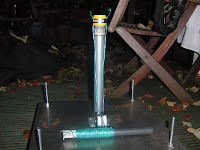


Part 2: This covers From January 2010 to July 2010 After our previous failures we did nothing for a month or two and decided to do some proper research into rockets, water rockets and the way they fly, this mainly lead us to Air Commands website which had a bottomless pit of the information we were seeking and links if they themselves did not directly have the information :).
So taking our new know how we rebuilt our small fleet of W-Rockets, a slightly more stable launcher (slightly being the operative word) and a new Nozzle. This was also the start of us using correx/coriflute plastic for fin material.


The rockets on there maiden flight's flew almost flawlessly this time round, we finally had a small fleet of rockets that worked. Filled with our new success we started to look at making a Robinson Joined Pair and succeeded in making a pressure vessel we called Nexus I (Nexus meaning join or joint), this was pressure tested but we felt we needed a more effective method of rocket recovery.


As a result of this we adapted Air Commands instructions on how to make a flight computer controlled parachute deploying nosecone, so that it would be operated by a RC receiver instead of the flight computer. This was then flown as an assembly we called Basic IV or B IV.


During this flight the rocket took off and immediately arched over to 45 degrees and the recovery system failed this caused the rocket to hit the ground still traveling at a high rate of speed crumpling the top of the rocket. On inspection of the scenario the launcher we decided was unstable and inadequate for further use, as it was the cause for the sudden arching over due to the release head being able to move around almost freely. Then turning to the recovery system failure on arrival to the landing site we discovered the parachutes were in fact stuck in the opening of the parachute bay, this lead us to redesigning the system mainly enlarging the door to the parachute bay. Also a new design for a launcher was created. To this day however the new system has not been flown, but has been extensively tested on the ground, also none of the Nexus series have been flown due to the wait its had on the recovery system.
This update brings all our previous endeavours to light up to the present moment in time in which this blog was created. So i will say a massive thank you to my friends who started the hobby with me and help in the making of the rockets, the prep work for our field days and of course the launching of the rockets. A big thanks also goes to the Air Command Group and George Katz for the great source of information and help on there brilliant website(
http://aircommandrockets.com/), It was was made us fully aware of the extents this hobby can go to and made us stick with it and want to carry on making our own rockets based on ideas and techniques found.
Thank you very much for reading, i hope you have enjoyed the backlogs part 1 and 2.
Regards Doug.


 Our usual Launchsite
Our usual Launchsite





 FRACTURE I fully assembled it stands at 102 cm.
FRACTURE I fully assembled it stands at 102 cm.

















 Holes marked and drilled
Holes marked and drilled
 Launch cord attached and coiled up.
Launch cord attached and coiled up.
 First attempt at a cable tie launcher
First attempt at a cable tie launcher Our first nozzle, it is not clear in this picture how awfully made this was.
Our first nozzle, it is not clear in this picture how awfully made this was. B III (
B III (










